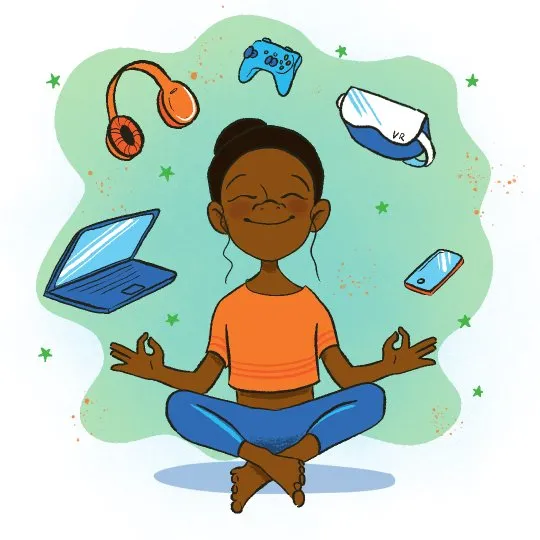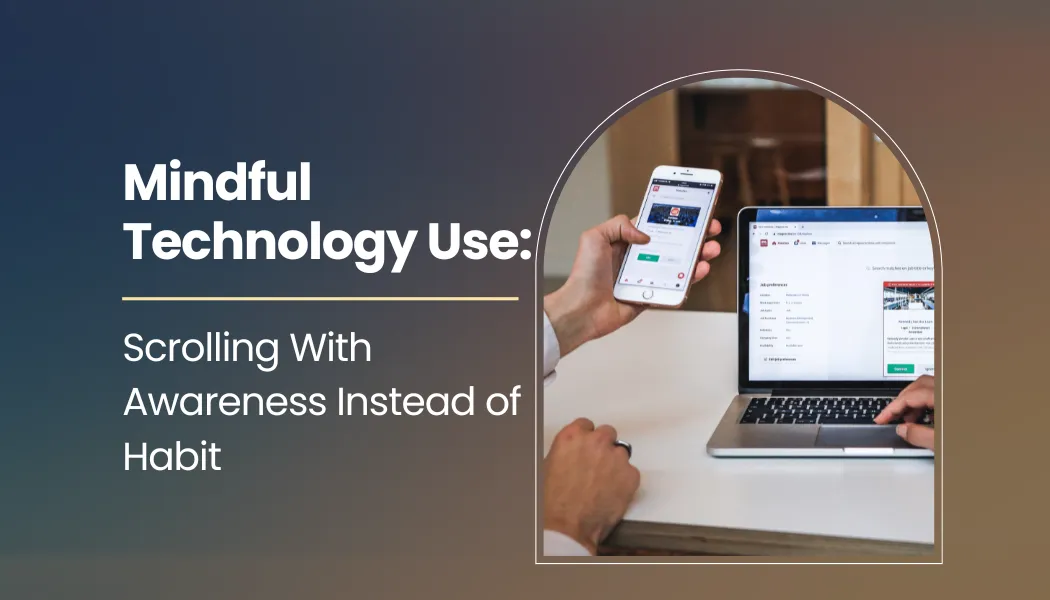It’s late at night. You reach for your phone, promising yourself just five minutes of catching up on social media or the news. Suddenly, forty minutes have passed, your eyes are tired, and sleep feels distant. This is a familiar scene for millions of people around the world. Technology, particularly the smartphone, has transformed the way we live, work, and connect. But it has also created patterns of habitual scrolling—moments where our thumbs move faster than our minds, where presence slips away, and where time dissolves in an endless stream of content.
The digital age is not the enemy. Our devices are powerful tools that connect us to loved ones, offer instant knowledge, and provide platforms for creativity. The problem arises when we use them without awareness. Instead of intentionally choosing when and how to engage, we often scroll out of boredom, stress, or habit. This leads to disconnection—from ourselves, from our environment, and even from the very content we’re consuming.
This is where mindfulness comes in. Mindfulness is the art of being fully present in the moment, aware of our thoughts, feelings, and actions without judgment. Applying mindfulness to technology means reclaiming our relationship with devices—scrolling with awareness instead of habit. It’s not about throwing away your phone or avoiding social media forever. It’s about learning to use these tools consciously, so they enrich rather than drain your life.
In this article, we’ll explore the psychology behind scrolling, the costs of mindless use, and practical ways to build a healthier relationship with technology. You’ll discover strategies, inspiring stories, and step-by-step tools to make your digital life more intentional, meaningful, and balanced.
Table of contents
- The Science of Habitual Scrolling
- What Is Mindful Technology Use?
- Why It Matters – The Costs of Mindless Scrolling
- Practical Tools & Strategies
- Stories & Case Studies
- Mindfulness Practices for Digital Life
- A Cultural Shift – Digital Wellness Beyond the Individual
- Step-by-Step Action Plan
- Conclusion – Reclaiming Presence in a Digital World
The Science of Habitual Scrolling
Why is it so hard to put the phone down? The answer lies in neuroscience and design.
Smartphone apps—especially social media platforms—are built around the concept of variable rewards. Every time you scroll, there’s a chance you’ll find something funny, shocking, heartwarming, or relevant. This unpredictability mirrors the mechanics of slot machines. Your brain gets a dopamine hit when you encounter something rewarding, but because you don’t know when that reward will appear, you keep scrolling, chasing the next rush.
Push notifications, likes, comments, and the infamous infinite scroll feature all amplify this cycle. Instead of reaching a natural stopping point, content flows endlessly, encouraging prolonged use. Over time, your brain associates boredom, anxiety, or even short pauses in activity with the urge to check your phone. This becomes a habit loop: trigger → action → reward.
For many, the habit becomes automatic. You unlock your phone without thinking. You check apps reflexively, even when nothing urgent awaits. This autopilot mode is the opposite of mindfulness—it keeps you busy but not truly present.
What Is Mindful Technology Use?
Mindful technology use doesn’t mean rejecting screens altogether. It means bringing conscious awareness to how and why you engage with them. Instead of letting your device control your attention, you become the one making choices.
Here are some guiding principles of mindful tech use:
- Awareness of intention: Asking, “Why am I opening this app?” before doing so.
- Noticing physical cues: Recognizing body tension, tired eyes, or shallow breathing while scrolling.
- Being present: Engaging with one post, one article, or one conversation at a time, instead of mindlessly skimming.
- Stopping with purpose: Choosing a natural end point rather than scrolling until exhaustion.
It’s about turning scrolling from a passive reflex into an active, intentional action.
Why It Matters – The Costs of Mindless Scrolling
At first glance, habitual scrolling seems harmless—just a way to pass time. But research shows it has significant effects on our mental health, productivity, and relationships.

1. Mental Health
Constant scrolling exposes us to comparison, information overload, and negative news cycles. Studies link excessive use with increased anxiety, depression, and feelings of loneliness. The irony is that platforms designed to connect us can, when used unconsciously, make us feel more isolated.
2. Productivity
On average, people check their phones 96 times per day—about once every ten minutes. Each distraction breaks focus, and it takes time to re-engage with tasks. Mindless scrolling eats away at hours that could be spent on deep work, creativity, or rest.
3. Relationships
Have you ever sat across from a friend or partner while both of you scrolled in silence? Mindless use erodes quality time. We may be physically present but emotionally absent, missing small moments of connection.
4. Sleep
Late-night scrolling delays bedtime, disrupts melatonin production through blue light exposure, and reduces sleep quality. A habit that feels relaxing can actually leave you more tired and stressed.
By practicing mindful technology use, we can reverse these trends—protecting mental health, reclaiming time, and nurturing stronger relationships.
Practical Tools & Strategies
How do we move from mindless to mindful scrolling? Here are proven strategies that anyone can start today.
1. Set Intentional Check-Ins
Before unlocking your phone, pause and ask: “Why am I opening this? What do I hope to gain?” If the answer is unclear, take a breath instead.
2. Create Tech-Free Zones
Designate areas like the dining table, bedroom, or morning routine as phone-free. This ensures that at least parts of your day remain grounded in the present.
3. Use App Limits & Focus Tools
Most smartphones now offer digital wellbeing features that track screen time and allow app restrictions. Treat them not as punishment but as gentle reminders.
4. Slow Your Scroll
Practice pausing after each post or article. Instead of instantly moving on, take a breath, reflect, or even jot down a thought. This transforms scrolling into an intentional experience.
5. Curate Your Feed
Unfollow accounts that leave you drained or anxious. Follow creators and communities that uplift, educate, or genuinely inspire. A mindful feed supports mindful use.
6. Embrace Micro-Breaks
Every 20–30 minutes of screen use, step away. Stretch, hydrate, or look out a window. These pauses reconnect you with your body and surroundings.
7. Practice a Digital Sunset
Set a time in the evening when screens are turned off, allowing your brain to unwind naturally before sleep.
Stories & Case Studies
To illustrate the power of mindful scrolling, let’s explore a few real-life examples:
- Anna, a university student: She noticed her anxiety spiked after late-night TikTok sessions. By setting a bedtime screen curfew and replacing the habit with a short meditation, her sleep improved and so did her grades.
- Raj, a marketing professional: Constant notifications disrupted his workflow. He began using focus modes that silenced non-essential apps during work hours. Within weeks, he felt less stressed and more productive.
- Lena, a mother of two: Family dinners often dissolved into everyone staring at screens. She introduced a “basket rule” where phones were left aside during meals. The result? More laughter, more stories, and a deeper sense of connection.
These stories show that small, mindful adjustments can create meaningful change.
Mindfulness Practices for Digital Life
Mindful technology use isn’t just about discipline—it’s about integrating mindfulness practices into your digital habits.
- Breathing with notifications: When your phone buzzes, pause. Take one deep breath before responding. Notice how this changes your reaction.
- One-task focus: If you’re watching a video, just watch. If you’re reading, just read. Avoid multitasking across apps.
- Gratitude scroll: Each time you open social media, intentionally like or comment only on posts that spark genuine gratitude or joy.
- Mindful lock screen: Use wallpapers with reminders like “Take a breath” or “What’s your intention?” to create a moment of reflection before entering.
These practices turn your phone from a distraction into a mindfulness tool.
A Cultural Shift – Digital Wellness Beyond the Individual
Mindful technology use is not only a personal responsibility; it’s becoming a cultural movement.

- Schools: Many are introducing digital wellness curricula, teaching students how to balance screen time with real-world activities.
- Workplaces: Companies are promoting focus time, no-email weekends, and wellness apps to support employee mental health.
- Tech Companies: Even platforms themselves are experimenting with mindful design—features like “You’re All Caught Up” reminders or screen time dashboards.
This shift recognizes that the problem is not just individual willpower but systemic design. Collective awareness creates healthier digital environments for everyone.
Step-by-Step Action Plan
Here’s a simple roadmap to start practicing mindful technology use today:
- Awareness: Track your screen time for one week without judgment.
- Intention: Write down why you want to change—better sleep, stronger relationships, more focus.
- Boundaries: Choose one tech-free zone (like the bedroom) and one mindful routine (like pausing before unlocking your phone).
- Experiment: Try one new practice each week, such as a digital sunset or mindful breathing with notifications.
- Reflect: Notice how these changes impact your mood, focus, and connections.
- Sustain: Adjust strategies as needed and celebrate progress, no matter how small.
Mindfulness is not about perfection—it’s about presence. Even a single mindful moment interrupts the cycle of habit and opens space for choice.
Conclusion – Reclaiming Presence in a Digital World
Technology is here to stay, and that’s a good thing. It offers incredible opportunities for learning, connection, and creativity. But without awareness, it can steal our attention, leaving us restless and disconnected.
Mindful technology use is about reclaiming presence. It’s about shifting from scrolling out of habit to scrolling with awareness. When we bring mindfulness to our devices, we rediscover time, peace, and connection—not by rejecting technology, but by reshaping how we engage with it.
The next time you pick up your phone, pause for just a moment. Breathe. Ask yourself: “Am I choosing this, or is it choosing me?” That single question might be the first step toward transforming your digital life from a series of mindless scrolls into a journey of intentional living.
